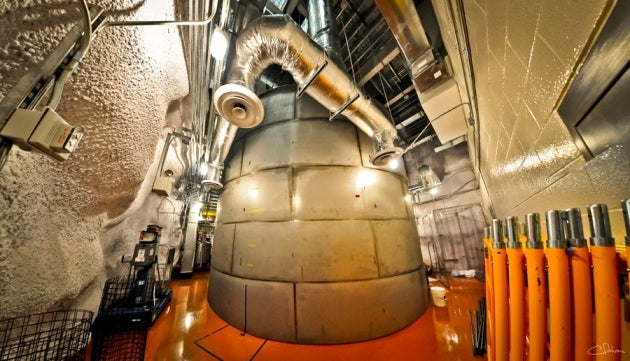
First Results from LUX, the World’s Most Sensitive Dark Matter Detector


Almost a mile deep in the Black Hills of South Dakota sits the Large Underground Xenon (LUX) experiment, which, after its first run of more than three months, has proved itself the most sensitive dark matter detector in the world.
So far, dark matter — the predominant form of matter in the universe — has been observed only by its gravitational effects on galaxies and clusters of galaxies.
"Astronomers and astrophysicists have gold-plated proof that dark matter exists," said UC Santa Barbara physicist Harry Nelson, who helped design, build and fill the sophisticated water tank that houses the LUX experiment. "What we're trying to do is touch it here on Earth."
LUX is looking for weakly interacting massive particles, or WIMPs, so-called because they rarely interact with ordinary matter except through gravity. WIMPs are the leading theoretical candidates for dark matter. Theories and results from other experiments suggest that WIMPs could be either high-mass (about the same mass as a calcium atom) or low-mass (about the same mass as a carbon atom).
At the heart of the LUX experiment is a 6-foot-tall titanium tank filled with almost a third of a ton of liquid xenon, cooled to minus 150 degrees Fahrenheit. Xenon is a chemical element that occurs in the Earth's atmosphere in trace amounts. If a WIMP strikes a xenon atom, it recoils from other xenon atoms and emits photons (light) and electrons. The electrons are drawn upward by an electric field and interact with a thin layer of xenon gas at the top of the tank, releasing more photons.
Light detectors in the top and bottom of the tank are each capable of detecting a single photon, so the locations of the two photon signals — one at the collision point, the other at the top of the tank — can be pinpointed to within a few millimeters. The energy of the interaction can be precisely measured from the brightness of the signals.
"LUX is a complex instrument," said Dan McKinsey, a physicist at Yale University and co-spokesperson for LUX, "but it ensures that each WIMP event's unique signature of position and energy will be precisely recorded."
LUX also has greatly enhanced sensitivity to low-mass WIMPs, whose possible detection has been suggested by other experiments. Three candidate WIMP events recently reported in ultracold silicon detectors, however, would have produced more than 1,600 events in LUX's much larger detector, or one every 80 minutes in the recent run. No such signals were seen.
"These new results completely rule out some hints of possible dark matter from earlier experiments," said Michael Witherell, UCSB's vice chancellor for research and a professor of physics. "We will be able to do a much more sensitive search next year with this powerful new instrument. I am very excited to see what we find out."
In both theory and practice, collisions between WIMPs and normal matter are rare and extremely difficult to detect, especially because a constant rain of cosmic radiation from space can drown out the faint signals. That's why LUX is searching for WIMPs 4,850 feet underground in the Sanford Lab, where few cosmic ray particles can penetrate. The detector is further protected from background radiation from the surrounding rock by immersion in a tank of ultrapure water.
UCSB's LUX team was responsible for operating the water system that supplies 72,000 gallons of exceedingly pure water.
"It's so pure it feels dry in your mouth if you drink some," Nelson said. "The system is a souped-up version of the water purification system used in commercial car washes. Ultrapure water is greatly depleted in radioactive impurities from uranium and thorium that might cause a fake dark matter signal."
LUX's biggest advantage as a dark matter detector is its size — a large xenon target whose outer regions further shield the interior from gamma rays and neutrons. Its first run of three months was conducted this spring and summer, followed by intensive analysis of the data. The dark matter search will continue through the next two years.
Planning for the next-generation dark matter experiment at the Sanford Lab is already underway. The LUX-ZEPLIN, or LZ, experiment will have a seven-ton liquid xenon target inside the same 72,000-gallon tank of pure water used by LUX. Case Western Reserve University physicist Tom Shutt, the spokesman for LZ and a previous co-spokesperson for LUX, said one goal of LUX is to figure out how to build an even larger detector.
In addition to principle investigators Nelson and Witherell, the UCSB LUX Team includes postdoctoral scholar María del Carmen Carmona Benítez, graduate students Curt Nehrkorn and Scott Haselschwardt and engineers Susanne Kyre and Dean White.
The UCSB LUX group is supported by the Department of Energy Office of High Energy Physics and by UCSB.



